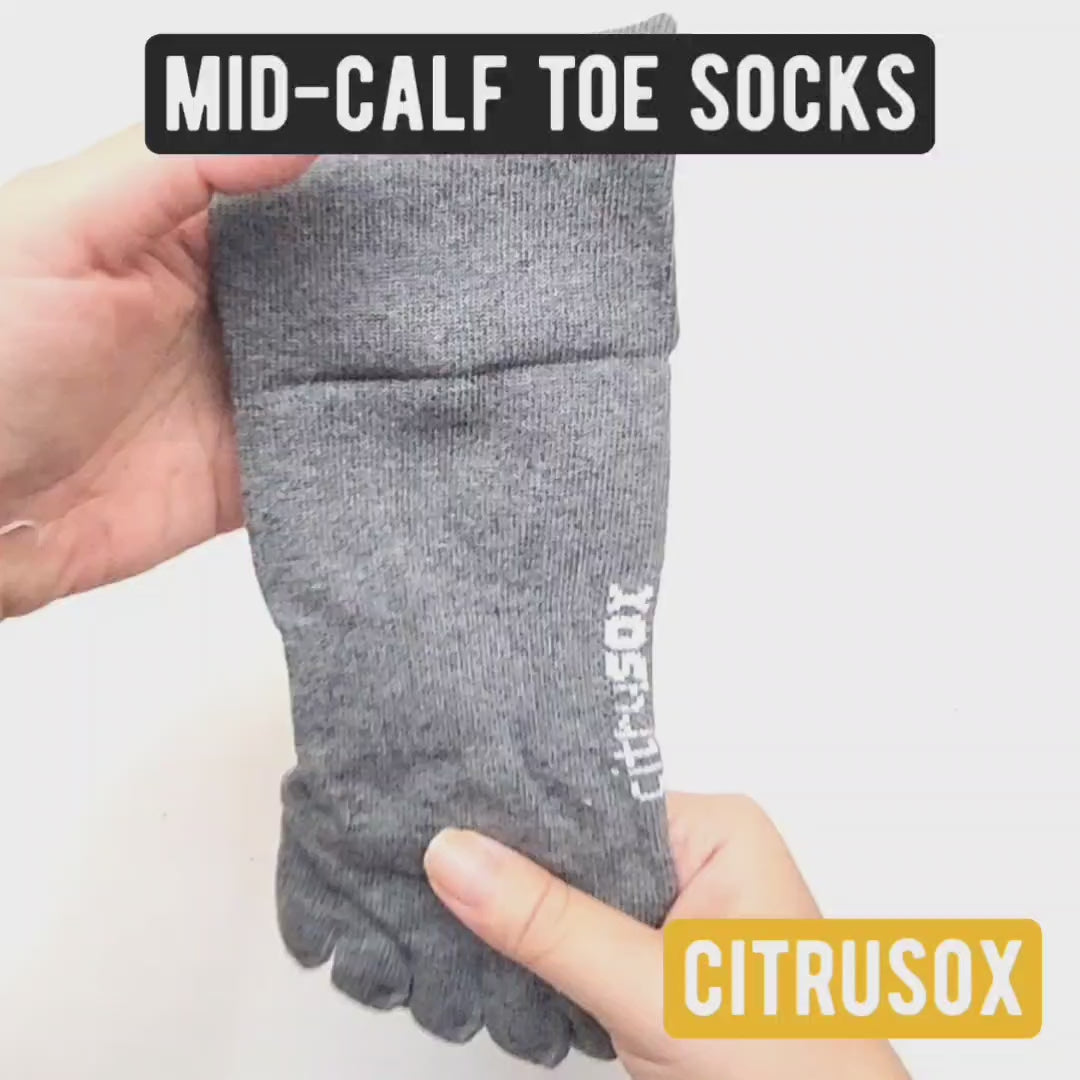From Merino Wool to Cotton: Choosing the Right Sock Material for Every Occasion
Have you ever tripped on a pair of socks that just didn't feel right? Perhaps they were too hot for a warm day or failed to perform after a lengthy stroll. We get it—and that's precisely why at Citrusox, we care about making it easy for you to choose the right sock fabric for any given scenario. Whether you're using cotton for ventilation, wool for insulation, or nylon for strength, the fabric is more important than you know. Let's go into how every sock material—particularly Merino wool, cotton, wool, and nylon—is involved in your daily comfort.
Understanding the Basics of Sock Materials
Not all socks are built the same. The type of fabric used affects how breathable, insulating, moisture-wicking, or durable the socks are. Here’s a breakdown of common sock materials and what they offer:
-
Cotton: Lightweight, breathable, and ideal for casual daily use.
-
Wool: Insulating, warm, and better suited for colder weather.
-
Nylon: Synthetic, strong, and often blended in for elasticity and durability.
Knowing when to wear each type helps you maintain foot comfort and prevent issues like blisters, odour, or overheating.
When to Choose Cotton Socks
Cotton socks are one of the most common types of socks. They're soft and breathable, making them ideal for everyday use, especially in warm or moderate climates.
Cotton performs best when:
-
You’re indoors or in dry conditions
-
You want a lightweight, breathable option
-
You need socks for light walking or short errands
However, cotton absorbs moisture and retains it, which can be uncomfortable during intense activities or hot, sweaty days.
The Strengths of Wool Socks
Wool socks are popular for their insulating properties. They trap warmth and are naturally odour-resistant, making them useful in colder climates.
Wool works best when:
-
You’re exposed to cold environments
-
You need thick socks for hiking or boots
-
You want natural warmth without synthetic insulation
Regular wool, though warm, can sometimes feel coarse and bulky. It's also slower to dry compared to synthetic materials.
Why Merino Wool Is a Versatile Choice
Merino wool is a high-performance natural fiber. Unlike traditional wool, Merino wool is soft, lightweight, and ideal for both warm and cool weather. It also wicks moisture and resists odour, making it great for long days or active wear.
Merino wool is suitable when:
-
You’re active or on your feet for long hours
-
You need temperature regulation across changing conditions
-
You prefer natural fibres that are soft and non-irritating
Thanks to its thermoregulating ability, Merino wool socks can be worn across seasons without making your feet too warm or too cold.
The Role of Nylon in Socks
Nylon is a synthetic material that’s often blended with natural fibers to improve durability, stretch, and shape retention. On its own, nylon is strong, smooth, and fast drying.
Nylon performs best when:
-
You need durable socks for physical activity
-
You want socks that retain shape after repeated washing
-
You’re wearing snug shoes that require stretch and form-fit
While not as breathable as cotton or Merino wool, nylon socks add structure and life to blends, especially for sports or compression socks.
Choosing Socks by Season
The right sock material can also depend on the weather. Here’s how materials match seasonal needs:
-
Summer: Lightweight cotton or cotton-nylon blends for breathability
-
Monsoon or Wet Season: Nylon or synthetic blends for quick drying
-
Winter: Wool or Merino wool for insulation and warmth
-
All-Year: Merino wool for moisture control and temperature regulation
Switching sock materials based on the season helps avoid discomfort like cold feet in winter or sweaty feet in summer.
Matching Socks with Activities
Different activities demand different types of socks. Wearing the right material can improve comfort and reduce fatigue or friction.
-
Office or indoor use: Soft cotton socks or cotton-nylon blends
-
Running and workouts: Moisture-wicking nylon or Merino wool
-
Outdoor or hiking: Insulating wool or Merino wool for longer wear
-
Travel or long days: Odour-resistant and breathable Merino wool
By choosing socks that suit the activity, you reduce the risk of overheating, blisters, or excessive moisture build-up.
Finding Balance with Material Blends
Socks today are rarely made from a single material. Blends of cotton, wool, Merino wool, and nylon help bring out the best of each material. For instance:
-
Cotton-nylon blends add durability to softness
-
Merino wool-nylon blends improve elasticity while keeping moisture away
-
Wool-cotton mixes add comfort and warmth without being too thick
Understanding these blends can help you choose socks that meet both your comfort and durability needs.
Find Your Perfect Pair at Citrusox
At Citrusox, we understand that choosing the right sock material can make a world of difference in how your day goes. That’s why we offer a wide range of socks—from Merino wool to cotton, wool, and nylon—each carefully selected to meet different needs. Our collection is thoughtfully designed to suit various lifestyles, weather conditions, and daily routines. With the right material, your socks can support comfort, durability, and function in every step you take.
Conclusion
Choosing the right sock material depends on your activity, environment, and comfort needs. Cotton, wool, Merino wool, and nylon each offer unique benefits suited for different occasions.
At Citrusox, we provide a range of socks made from carefully selected materials to match your lifestyle. Reach out to us now and experience the comfort your feet deserve!
FAQs
For everyday socks, cotton is one of the best materials due to its softness and breathability. Blends that include nylon can add stretch and improve durability, making them ideal for regular wear.
The healthiest socks are made from breathable materials like Merino wool or cotton that help regulate temperature and wick away moisture. These materials also reduce the risk of bacterial growth and skin irritation.
Nylon is one of the most durable materials used in socks, especially when blended with cotton or wool. These combinations help maintain shape and withstand frequent washing and use.
The best material for socks depends on the need—cotton for comfort, Merino wool for moisture control, wool for warmth, and nylon for strength. A blend of these materials often provides the most balanced performance.
Choosing the right socks involves considering your activity, climate, and comfort needs. Materials like cotton, wool, Merino wool, and nylon each serve different purposes depending on the situation.
Merino wool is highly effective for preventing smelly feet due to its moisture-wicking and odour-resistant properties. Unlike cotton, it keeps socks dry and fresh even after long hours.
While 100% cotton socks are soft, they may lack durability and moisture-wicking abilities. Blending cotton with nylon or Merino wool improves performance and longevity.
Bamboo socks are soft and breathable, similar to cotton, and can be a good option for sensitive skin. However, they may not be as durable as nylon or as insulating as wool or Merino wool.
Bamboo socks tend to wear out faster and may lose shape over time compared to nylon or wool blends. They also retain more moisture than Merino wool, which can lead to odour.
Cotton socks are generally more durable and better suited for everyday use, especially when blended with nylon. Bamboo socks are softer but may not perform as well under frequent use or high activity.
Good quality socks use high-grade materials like Merino wool, durable cotton, or reinforced nylon blends. They maintain their shape, have smooth seams, and resist wear even after multiple washes.
Merino wool socks are best for preventing sweating, as they wick moisture and regulate temperature effectively. Unlike plain cotton, which can absorb and hold sweat, Merino wool keeps feet dry and fresh.
Cotton socks are more breathable and comfortable for everyday wear, while polyester offers better moisture-wicking but less softness. A blend of cotton and nylon often provides a balance of comfort and performance.















